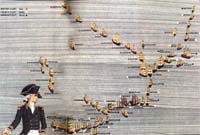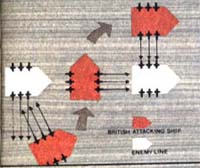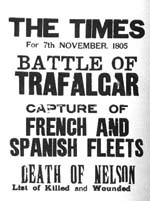|
It was the year of 1805, the
year when it seemed that at long last Napoleon would invade England,
which, for twelve years, had stood in the path of the Grand Armée´s
complete domination of Europe. It was the year when, in the face
of all the evidence to the contrary, Napoleon had suddenly convinced
himself that his united fleet could annihilate any squadron which
the English could put to sea to meet it.
 In August
of 1805, he wrote to his admirals: „Come into the Channel.
Bring our united fleet and England is ours. If you are only here
for 24 hours, all will be over, and six centuries of shame and
insult will be avenged." In August
of 1805, he wrote to his admirals: „Come into the Channel.
Bring our united fleet and England is ours. If you are only here
for 24 hours, all will be over, and six centuries of shame and
insult will be avenged."
It was an order, however, which his captains found impossible
to obey. Although Napoleon had 2,000 ships and 90,000 men assembled
along the coast of France, the British blockade of the French
and Spanish harbours had virtually ammobilised this gigantic
force.
In desperation, Napoleon ordered his fleet at Cadiz to sail out
and meet the enemy ships which sat quietly waiting on the green
Atlantic swells at Cape Trafalgar, some 80 kilometres east of
Cadiz.
„His Majesty counts for nothing the loss of his ships,"
Napoleon´s message ended, „provided they are lost
with glory."
In response to this order, a Franco-Spanish fleet of 33, with
2,640 guns, commanded by Admiral Villeneuve, set out from Cadiz
to engage the enemy. Massive though this force was compared to
the force that awaited them, its destruction was an almost foregone
conclusion from the very beginning.
There were several reasons for the inevitable destruction of
the Franco-Spanish fleet, not the least being that it was commanded
by a man who was haunted by the memory of his humiliating defeat
at the hands of a much smaller English force only three months
earlier. A man, moreover, that even Napoleon had decided at the
last moment was ill-fitted for the task that had been entrusted
to him.
As Villeneuve was sailing out of Cadiz, a horseman was hastening
down the Spanish Peninsula, carrying a message, informing Villeneuve
that he was to hand over his command to Admiral Rosily.
It would be wrong to assume that if the messenger had arrived
in time to stop Villeneuve sailing, and the highly capable Admiral
Rosily had been in command, the outcome of the Battle of Trafalgar
might have been a different one. There were too many other factors
weighed in the balance against the Franco-Spanish fleet for this
to have happened.
Like Villeneuve, the captains of the Freench and Spanish fleets
were imbued with a sense of impending defeat before they had
even encoutered the enemy. And with good cause!
Demoralised by a long period of inactivity, and with 1,700 sick
men aboard their ships, the French sailed out of Cadiz knowing
that only a miracle could give them a victory.
Press-ganged crews
The Spanish ships, manned mostly
by soldiers or by beggars press-ganged from the slums of Cadiz,
with gunners who had never fired a gun from a rolling ship, and
commanded by Spanish captains who resented being placed under
a French admiral, were in an even worse plight.
Most unnerving of all for the captains of the fleet was the knowledge
that they were about to put themselves against the most skilful
sea captain of all time - Horatio Viscount Nelson.
Only slightly less awe-inspiring was the British Jack Tar himself,
that clay-piped, pig-tailed sailor, who, more often than not,
had been recruited by the press gangs from the scourings of the
English sea towns. Already an aggressive fighting man by instinct,
he had literally been whipped into becoming a magnificent sailor
by the iron discipline of autocratic captains for whom the lash
was the answer to almost every infringement of the ship´s
rules.
A seasoned French sailor would have had difficulty in holding
his own against such a formidable foe, let alone those pathetic
crews sailing out to meet the English fleet.
On the 20th of October, 1805, the Franco-Spanish fleet was sighted,
and soon afterwards the area where the British ships waited became
bright with patches of gaudy bunting as each ship broke out strings
of flags which assed on the message: „The French and Spanish
are out at last, they outnumber us in ships and guns and men:
we are on the eve of the greatest sea fight in history."
On board the flagship, HMS Victory, the message had been delivered
to the English commander, a slight, one-armed man, blind in one
eye and shabbily dressed in a threadbare frock coat stained with
sea salt, its gold lace tarnished to black flattened rags.
Battle plans
This slatternly-looking admiral
was, of course, Lord Nelson, who received the news with the utmost
calmness. And why not? His battle plans had already been made
and communicated to all his captains. Those plans, he was convinced
would give him a swift victory.
Until the Battle of Trafalgar, the problem of how a fleet could
gain an annihilating victory over the enemy was one that had
never really been solved, and for want of a better tactic, it
had been the custom for the fleets to sail into action in two
parallel lines, with each ship taking on a single opponent, firing
its guns broadside as it passed.
Inevitably, the enemy would také an opposite tack, and
the battle would then become a vastly prolonged affair, with
the ships continually sailing on opposite tacks, or engaging
on the same tack, until one of the fleets eventually retired.
Nelson had decided to break completely with this tradition. His
plan was to divide his fleet into two groups. One group would
attack sections of the enemy line and destroy them before other
ships could come to their aid. The other group would attack the
enemy at right angles, break through their lines and then cut
off the retreat of the enemy fleet.
This aggressive piece of strategy, which was later referred to
as the „Nelson Touch", was to change the whole course
of naval warfare.
The battle did not begin until the following day, by which time
the enemy fleet was well in sight, off Cape Trafalgar. Nelson
was on deck, now in a freshly laundered uniform and with new
ribbons for all the medals on his breast.
Battle signal
Shortly after, Nelson called
for the signal officer. „Make the signal to bear down on
the enemy in two lines," he ordered. He then went down to
make his will, which was witnesssed by Captain Hardy and Captain
Blackwood who had come aboard from the Euryalus. Afterwards,
Nelson went up to the poop and ordered that signal officer to
hoist his celebrated signal: ENGLAND EXPECTS THAT EVERY MAN WILL
DO HIS DUTY.
It has been said that this famous signal was to have been worded:
„Nelson confides that every man will do his duty,"
and that his name was replaced by that of England at the suggestion
of the signal officer, who pointed out that if the words „confides
that" were used, they would have to be spelt out with a
long string of flags. The word „expects" was substituted.
First blood
The first shot was fired at the
English ship Royal Sovereign at noon. This salute of iron was
received in silence by the Royal Sovereign, who waited until
she had drawn astern of the Spanish three-decket, Santa Anna,
then raked her decks with a murderous fire that killed or wounded
400 of her crew.
In the meantime, Nelson´s ship was moving on, silent and
intent, searching for the French admiral´s ship. Eventually,
right in front of her, lay the huge Spanish four-decker, Santissima
Trinidad. Guessing correctly that the French admiral´s
ship must be nearby, Nelson bore down on her. As he did so, the
Bucentaure, Villeneuve´s ship, and seven or eight other
enemy ships, opened fire on the Victory. Still she advanced without
firing. By the time she had come close enough to rake the Santissima
Trinidad with her larboard guns, 50 of her men were dead and
30 wounded.
It was at this point that the Victory came into collision with
the French Redoubtable. Locked together, and wrapped in sheets
of flame, the two ships drifted slowly through the smoke of battle.
Gradually, although the fighting had continued unabated, the
smoke cleared a little from the decks of the Victory, enough
for the marksmen to see the epaulets of the English officers.
A marksman kneeling in the mizzen-top aimed his musket at Nelson.
On the quarterdeck of the Victory, Captain Hardy had turned to
leave Nelson´s side to give an order when Nelson fell,
mortally wounded. Immediately, Hardy, a sergeant of the marines
and two privates, rushed forward to lift him up. Nelson was then
carried down to the cockpit, where he ordered that his face should
be covered with a handkerchief so that he might not be recognized.
In the meantime, the Redoubtable´s top marksmen had shot
down 40 officers and men, destroying so many that the French,
seeing the upper deck clear of all but dead or wounded, tried
to board her. It was an enterprise which was to cost them dear.
A botswain´s whistle piped, „Boarders; repel Boarders",
and the order immediately summoned swarms of smoke-begrimed blue-jackets
to the deck, where they killed every man who had managed to board
the Victory.
Below decks, Nelson´s life was now ebbing away fast. But
he was still alive when Hardy returned from the fighting above
to inform him that fourteen enemy vessels had given in. „That´s
well," Nelson said, „but I had bargained for twenty."
He lingered on for a little while longer. After murmuring some
inarticulate words, he said distinctly, „I have done my
duty. I thank God for it!"
 |
|
The first stage of the battle, with
the Victory leading a frontal attack, while the rest of Nelson´s
fleet attacks at right angles to break through the lines of the
enemy ships, and thus cut off their retreat. This tactic was
in complete variance with all the accepted rules of naval warfare. |
|
 The
last stage of the battle, with the French and English ships engaged
in a general melée. By then 25 French ships were already
out of action and trying to make for Cadiz. The
last stage of the battle, with the French and English ships engaged
in a general melée. By then 25 French ships were already
out of action and trying to make for Cadiz. |
 |
The raking manoeuvre employed with
great success by the British ships. When attacking the enemy
line, a British vessel would steer for a gap between enemy vessels.
After brilliant seamanship had gained the British ship an advantageous
position, a broadside was fired at one enemy vessel before sailing
in front of it to unleash yet another broadside into the stern
of the next ship in the line. Yet another broadside was then
delivered to that crippled vessel from the other side. |
|
Ruined dream
Above,beneath the setting sun,
his fleet was lying in two groups with the shattered hulks of
the enemy ships all around them. The British losses had been
heavy; 449 killed and 1,241 wounded. But of the 27 ships of the
British fleet, not one had been sunk or captured. Trafalgar was
the decisive battle of the Napoleonic Wars.
It had always been essential to Napoleon´s master plan
to control the world that he should have command of the seas.
With his Allied fleet now ruined as a fighting force thet dream
had been destroyed forever.
Trafalgar, moreover, established England´s supremacy at
sea for nearly a century and a half, during which time her navy
remained the bedrock on which her control of the far-flung British
Empire rested through the age of steam and into the 20th century. |

 In August
of 1805, he wrote to his admirals: „Come into the Channel.
Bring our united fleet and England is ours. If you are only here
for 24 hours, all will be over, and six centuries of shame and
insult will be avenged."
In August
of 1805, he wrote to his admirals: „Come into the Channel.
Bring our united fleet and England is ours. If you are only here
for 24 hours, all will be over, and six centuries of shame and
insult will be avenged."
 The
last stage of the battle, with the French and English ships engaged
in a general melée. By then 25 French ships were already
out of action and trying to make for Cadiz.
The
last stage of the battle, with the French and English ships engaged
in a general melée. By then 25 French ships were already
out of action and trying to make for Cadiz.
